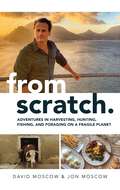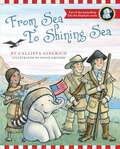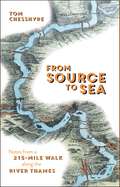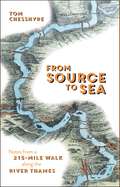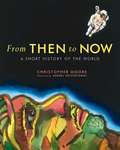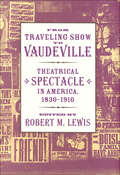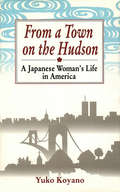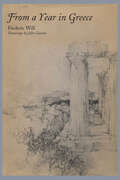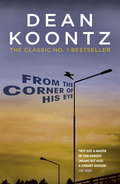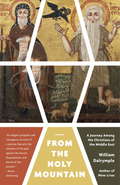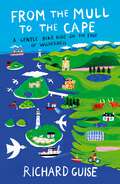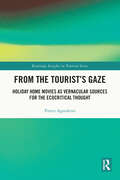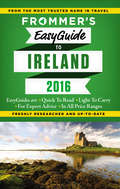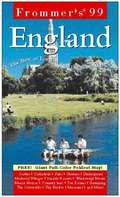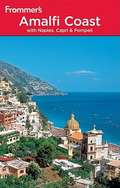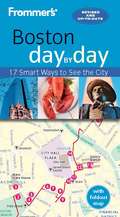- Table View
- List View
From Scratch: A Memoir of Love, Sicily, and Finding Home
by Tembi LockeNow a limited Netflix series starring Zoe Saldaña! This Reese Witherspoon Book Club Pick and New York Times bestseller is &“a captivating story of love lost and found&” (Kirkus Reviews) set in the lush Sicilian countryside, where one woman discovers the healing powers of food, family, and unexpected grace in her darkest hours.It was love at first sight when actress Tembi met professional chef, Saro, on a street in Florence. There was just one problem: Saro&’s traditional Sicilian family did not approve of his marrying a black American woman. However, the couple, heartbroken but undeterred, forged on. They built a happy life in Los Angeles, with fulfilling careers, deep friendships, and the love of their lives: a baby girl they adopted at birth. Eventually, they reconciled with Saro&’s family just as he faced a formidable cancer that would consume all their dreams. From Scratch chronicles three summers Tembi spends in Sicily with her daughter, Zoela, as she begins to piece together a life without her husband in his tiny hometown hamlet of farmers. Where once Tembi was estranged from Saro&’s family, now she finds solace and nourishment—literally and spiritually—at her mother-in-law&’s table. In the Sicilian countryside, she discovers the healing gifts of simple fresh food, the embrace of a close knit community, and timeless traditions and wisdom that light a path forward. All along the way she reflects on her and Saro&’s romance—an incredible love story that leaps off the pages. In Sicily, it is said that every story begins with a marriage or a death—in Tembi Locke&’s case, it is both. &“Locke&’s raw and heartfelt memoir will uplift readers suffering from the loss of their own loved ones&” (Publishers Weekly), but her story is also about love, finding a home, and chasing flavor as an act of remembrance. From Scratch is for anyone who has dared to reach for big love, fought for what mattered most, and those who needed a powerful reminder that life is...delicious.
From Scratch: Adventures in Harvesting, Hunting, Fishing, and Foraging on a Fragile Planet
by David Moscow Jon MoscowDavid Moscow, the creator and star of the groundbreaking series From Scratch, takes us on an exploration of our planet&’s complex and interconnected food supply, showing us where our food comes from and why it matters in his new book of global culinary adventures.In an effort to help us reconnect with the food that sustains our lives, David Moscow has spent four years going around the world, meeting with rock-star chefs, and sourcing ingredients within local food ecosystems—experiences taking place in over twenty countries that include milking a water buffalo to make mozzarella for pizza in Italy; harvesting oysters in Long Island Sound and honey from wild bees in Kenya; and making patis in the Philippines, beer in Malta, and sea salt in Iceland. Moscow takes us on deep dives (sometimes literally) with fisherfolk, farmers, scientists, community activists, historians, hunters, and more, bringing back stories of the communities, workers, and environments involved—some thriving, some in jeopardy, all interconnected with food. The result is this travel journal that marvels in the world around us while simultaneously examining the environmental issues, cultural concerns, and overlooked histories intertwined with the food we eat to survive and thrive. Through the people who harvest, hunt, fish, and forage each day, we come to understand today&’s reality and tomorrow&’s risks and possibilities.
From Sea to Shining Sea
by Callista Gingrich Susan ArcieroEllis the Elephant is back and ready for another adventure in American history! In From Sea to Shining Sea, the fourth installment of Callista Gingrich’s New York Times bestselling series, Ellis explores the early years of the United States and heads west into uncharted territory with Lewis and Clark.In previous books, Sweet Land of Liberty, Land of the Pilgrims’ Pride, and Yankee Doodle Dandy, Ellis learned about pivotal moments that have shaped America. Now, in From Sea to Shining Sea, America’s favorite time-traveling pachyderm discovers a new and growing nation along with George Washington, Thomas Jefferson, Lewis and Clark, Sacagawea and others.Authored by Callista Gingrich and illustrated by Susan Arciero, From Sea to Shining Sea will delight those who want to know how brave Americans forged a growing nation and spread freedom from coast to coast.
From Source to Sea: Notes from a 215-Mile Walk Along the River Thames
by Tom ChesshyreAuthors, artists and amblers have always felt the pull of the Thames, and now Tom Chesshyre is following in their footsteps. He’s walking more than 200 miles from the Cotswolds to the North Sea. Seeing some familiar sights through new eyes, Chesshyre explores the living present and remarkable past of England’s longest and most iconic river.
From Source to Sea: Notes from a 215-Mile Walk Along the River Thames
by Tom ChesshyreAuthors, artists and amblers have always felt the pull of the Thames, and now Tom Chesshyre is following in their footsteps. He’s walking more than 200 miles from the Cotswolds to the North Sea. Seeing some familiar sights through new eyes, Chesshyre explores the living present and remarkable past of England’s longest and most iconic river.
From Source to Sea: Notes from a 215-Mile Walk Along the River Thames
by Tom ChesshyreAuthors, artists and amblers have always felt the pull of the Thames, and now Tom Chesshyre is following in their footsteps. He’s walking more than 200 miles from the Cotswolds to the North Sea. Seeing some familiar sights through new eyes, Chesshyre explores the living present and remarkable past of England’s longest and most iconic river.
From Source to Sea: Notes from a 215-Mile Walk Along the River Thames
by Tom ChesshyreAuthors, artists and amblers have always felt the pull of the Thames, and now Tom Chesshyre is following in their footsteps. He’s walking more than 200 miles from the Cotswolds to the North Sea. Seeing some familiar sights through new eyes, Chesshyre explores the living present and remarkable past of England’s longest and most iconic river.
From Then to Now: A Short History of the World
by Christopher MooreTraces human civilization from early bands of hunter-gatherers to the multicultural world cities of the present, covering the development of agriculture, empires, law, and the major religions, the rise of Europe, colonies, and industrialization.
From Traveling Show to Vaudeville: Theatrical Spectacle in America, 1830–1910
by Robert M. LewisBefore phonographs and moving pictures, live performances dominated American popular entertainment. Carnivals, circuses, dioramas, magicians, mechanical marvels, musicians, and theatrical troupes—all visited rural fairgrounds, small-town opera houses, and big-city palaces around the country, giving millions of people an escape from their everyday lives for a dime or a quarter. In From Traveling Show to Vaudeville, Robert M. Lewis has assembled a remarkable collection of nineteenth- and early twentieth-century primary sources that document America's age of theatrical spectacle. In eight parts, Lewis explores, in turn, dime museums, minstrelsy, circuses, melodramas, burlesque shows, Wild West shows, amusement parks, and vaudeville.Included in this compendium are biographies, programs, ephemera produced by theatrical entrepreneurs to lure audiences to their shows, photographs, scripts, and song lyrics as well as newspaper accounts, reviews, and interviews with such figures as P. T. Barnum and Buffalo Bill Cody. Lewis also gives us reminiscences about and reactions to various shows by members of audiences, including such prominent writers as Mark Twain, William Dean Howells, Nathaniel Hawthorne, Carl Sandburg, Walt Whitman, Louisa May Alcott, Charles Dickens, O. Henry, and Maxim Gorky. Each section also includes a concise introduction that places the genre of spectacle into its historical and cultural context and suggests major interpretive themes. The book closes with a bibliographic essay that identifies relevant scholarly works.Many of the pieces collected here have not been published since their first appearance, making From Traveling Show to Vaudeville an indispensable resource for historians of popular culture, theater, and nineteenth-century American society.
From a Town on the Hudson
by Yuko KoyanoYuko Koyano spent five years in the United States in the 1980s as the wife of a Japanese businessman, the mother of two sons, and an observer in her own right. She believed that the experience would open a new window on the world for herself and her family, and she was not disappointed. From the outset, Ms. Koyano was a keen observer of American life in the New Jersey town where she lived just across the Hudson from Manhattan. She soon found that her study of English Literature in college in Japan had left her ill-prepared to understand the words in her sons' schoolbooks, not to mention the ones they picked up even more quickly in the schoolyard. Nor did contemporary life in the United States match the images she had grown up with on Japanese television reruns of American sitcoms. Not deterred, Ms. Koyano entered the life of everyday America, and its cast of characters-schoolteachers, senior citizens, taxi drivers, police officers, and postal clerks-fill the pages of this affectionate memoir. The vignettes captured in From a Town on the Hudson delight, amuse, and touch the reader, and give us-host and visitor alike-an opportunity to see ourselves as others see us.
From a Year in Greece
by Frederic WillIn this book, the reader is privileged to take a leisurely and thoroughly enjoyable trip through the Greece of the mid-twentieth century, led by a poet-narrator who is a comfortable and engaging guide and complemented by the artwork of John Guerin. Frederic Will recounts his odyssey: from Austria through Yugoslavia, across the northern Greek border, from Salonika to Athens and the Aegean Sea, to the site of remnants of Old Greece in Smyrna, Pergamum, and Ephesus, and finally to the monasteries on Mount Athos. The author not only presents vivid descriptions of the towns and people in contemporary Greece but also conveys the still-present aura of the ancient Greek deities, in both the ruins and the modern cities. Witness the following passage written at Salonika, in Northern Greece, Will’s first stop of importance: The sense-binding, sense-shaping ocean is omnipresent there. It is visible from nearly any point in the city. You only need to go up to your second story—if you have one. There is that pure, rhythmic, bounded but boundless element, spread somewhere at the bottom of the street. The same vision glimmers or stirs at the end of nearly every east-west-running street. Many townsmen spend much of their time promenading along the harbor. They seem to be subliminally magnetized to the sea. I spent several weeks there. During that time I would often go up to the crowning Venetian walls, and look down onto Salonika and its harbor. From there Salonika’s deep dependence on the ocean became a fact proved by eyesight. The city is built on the half-moon-shaped plain of the Axios River. Two images came to me repeatedly: that Salonika is an amphitheater facing the ocean; or that she is a lover, reaching to embrace the ocean. Here are the hot, white (or cream-colored) buildings of the city; there is the element they thirst for. Will gives a great deal of fascinating information but gives it gracefully and without excess. Above all, the narrative is suffused with the atmosphere, the emotions, and the beauty of Greece. The author has said he intends for this work to dramatize, not to instruct. Actually, it does both.
From a Year in Greece
by Frederic WillIn this book, the reader is privileged to take a leisurely and thoroughly enjoyable trip through the Greece of the mid-twentieth century, led by a poet-narrator who is a comfortable and engaging guide and complemented by the artwork of John Guerin. Frederic Will recounts his odyssey: from Austria through Yugoslavia, across the northern Greek border, from Salonika to Athens and the Aegean Sea, to the site of remnants of Old Greece in Smyrna, Pergamum, and Ephesus, and finally to the monasteries on Mount Athos. The author not only presents vivid descriptions of the towns and people in contemporary Greece but also conveys the still-present aura of the ancient Greek deities, in both the ruins and the modern cities. Witness the following passage written at Salonika, in Northern Greece, Will’s first stop of importance: The sense-binding, sense-shaping ocean is omnipresent there. It is visible from nearly any point in the city. You only need to go up to your second story—if you have one. There is that pure, rhythmic, bounded but boundless element, spread somewhere at the bottom of the street. The same vision glimmers or stirs at the end of nearly every east-west-running street. Many townsmen spend much of their time promenading along the harbor. They seem to be subliminally magnetized to the sea. I spent several weeks there. During that time I would often go up to the crowning Venetian walls, and look down onto Salonika and its harbor. From there Salonika’s deep dependence on the ocean became a fact proved by eyesight. The city is built on the half-moon-shaped plain of the Axios River. Two images came to me repeatedly: that Salonika is an amphitheater facing the ocean; or that she is a lover, reaching to embrace the ocean. Here are the hot, white (or cream-colored) buildings of the city; there is the element they thirst for. Will gives a great deal of fascinating information but gives it gracefully and without excess. Above all, the narrative is suffused with the atmosphere, the emotions, and the beauty of Greece. The author has said he intends for this work to dramatize, not to instruct. Actually, it does both.
From the Corner of his Eye: A breath-taking thriller of mystical suspense and terror
by Dean KoontzAll he wanted was to make his mother proud... Dean Koontz's From the Corner of His Eye is an unforgettable thriller of suspense, danger and the supernatural. Perfect for fans of Stephen King and Richard Laymon.'A wonderful read. The pacing is perfect, keeping the reader in exquisite tension. This is a deeply satisfying, rich novel. You may have nightmares about [the villain] but you'll love the other characters. Singularly and collectively, they are unforgettable. From the Corner of His Eye is magic' - New Orleans Times-PicayuneBartholomew Lampion was blinded at the age of three, when surgeons reluctantly removed his eyes to save him from a fast-spreading cancer. But although eyeless, Barty regained his sight when he was thirteen.This sudden ascent from a decade of darkness into the glory of light was not brought about by a holy healer. No celestial trumpets announced the restoration of his vision, just as none had announced his birth.A rollercoaster had something to do with his recovery, as did a seagull. And you can't discount Barty's profound desire to make his mother proud of him before she died.The first time she died was the day Barty was born. January 6, 1965. What readers are saying about From the Corner of His Eye: 'At one stage I was so shocked by what happened I had to reread a few pages to make sure I hadn't misread... the twist was so surprising and so unexpected''This book had twists and turns to the last word''One of the best books I've ever read'
From the Holy Mountain
by William DalrympleIn the spring of A.D. 587, John Moschos and his pupil Sophronius the Sophist embarked on a remarkable expedition across the entire Byzantine world, traveling from the shores of Bosphorus to the sand dunes of Egypt. Using Moschos's writings as his guide and inspiration, the acclaimed travel writer William Dalrymple retraces the footsteps of these two monks, providing along the way a moving elegy to the slowly dying civilization of Eastern Christianity and to the people who are struggling to keep its flame alive. The result is Dalrymple's unsurpassed masterpiece: a beautifully written travelogue, at once rich and scholarly, moving and courageous, overflowing with vivid characters and hugely topical insights into the history, spirituality and the fractured politics of the Middle East.
From the Mull to the Cape: A Gentle Bike Ride on the Edge of Wilderness
by Richard GuiseRichard Guise yearned to take on a physical challenge, so he set off for an adventure on a 586-mile bike ride through the Highlands of Scotland. Guise discovers the little-known history of this unique part of Britain, picking up on the oddities and strange beauty of the place and telling it all with gentle humour.
From the Mull to the Cape: A Gentle Bike Ride on the Edge of Wilderness
by Richard GuiseRichard Guise yearned to take on a physical challenge, so he set off for an adventure on a 586-mile bike ride through the Highlands of Scotland. Guise discovers the little-known history of this unique part of Britain, picking up on the oddities and strange beauty of the place and telling it all with gentle humour.
From the Oven to the Table: Simple dishes that look after themselves
by Diana HenryTHE SUNDAY TIMES BESTSELLER'For bung-it-in-the-oven cooks everywhere, this is a must-have book: Diana Henry has a genius for flavour.' - Nigella LawsonWhether you're short of time or just prefer to keep things simple, From the Oven to the Table shows how the oven can do much of the work that goes into making great food. Diana Henry's favourite way to cook is to throw ingredients into a dish or roasting tin, slide them in the oven and let the heat behind that closed door transform them into golden, burnished meals. Most of the easy-going recipes in this wonderfully varied collection are cooked in one dish; some are ideas for simple accompaniments that can be cooked on another shelf at the same time. From quick after-work suppers to feasts for friends, the dishes are vibrant and modern and focus on grains, pulses and vegetables as much as meat and fish. With recipes such as Chicken Thighs with Miso, Sweet Potatoes & Spring Onions, Roast Indian-spiced Vegetables with Lime-Coriander Butter, and Roast Stone Fruit with Almond and Orange Flower Crumbs, Diana shows how the oven is the most useful bit of kit you have in your kitchen. Praise for How to Eat a Peach:'This is an extraordinary piece of food writing, pitch perfect in every way. I couldn't love anyone who didn't love this book.' - Nigella Lawson'...her best yet...superb menus evoking place and occasion with consummate elegance' - Financial TimesFood Book of the Year at the André Simon Food & Drink Book Awards 2019
From the Oven to the Table: Simple dishes that look after themselves
by Diana HenryTHE SUNDAY TIMES BESTSELLER'For bung-it-in-the-oven cooks everywhere, this is a must-have book: Diana Henry has a genius for flavour.' - Nigella LawsonWhether you're short of time or just prefer to keep things simple, From the Oven to the Table shows how the oven can do much of the work that goes into making great food. Diana Henry's favourite way to cook is to throw ingredients into a dish or roasting tin, slide them in the oven and let the heat behind that closed door transform them into golden, burnished meals. Most of the easy-going recipes in this wonderfully varied collection are cooked in one dish; some are ideas for simple accompaniments that can be cooked on another shelf at the same time. From quick after-work suppers to feasts for friends, the dishes are vibrant and modern and focus on grains, pulses and vegetables as much as meat and fish. With recipes such as Chicken Thighs with Miso, Sweet Potatoes & Spring Onions, Roast Indian-spiced Vegetables with Lime-Coriander Butter, and Roast Stone Fruit with Almond and Orange Flower Crumbs, Diana shows how the oven is the most useful bit of kit you have in your kitchen. Praise for How to Eat a Peach:'This is an extraordinary piece of food writing, pitch perfect in every way. I couldn't love anyone who didn't love this book.' - Nigella Lawson'...her best yet...superb menus evoking place and occasion with consummate elegance' - Financial TimesFood Book of the Year at the André Simon Food & Drink Book Awards 2019
From the Oven to the Table: Simple dishes that look after themselves
by Diana HenryThe beautiful new edition of Diana Henry's classic Crazy Water, Pickled Lemons is OUT NOW***'For bung-it-in-the-oven cooks everywhere, this is a must-have book: Diana Henry has a genius for flavour.' - Nigella Lawson-'This might be Henry's most useful book yet, which is saying something.' - The Sunday Times -'The shining star is Diana Henry's From the Oven to the Table, in which she faultlessly delivers highly achievable, boldly flavoured dishes.' - Meera Sodha, the Guardian-'A new cookbook from Diana Henry is always a reason to celebrate and From the Oven to the Table is no exception.' - Independent -'There's so much to love about the latest from the Sunday Telegraph writer. Its great strength lies in updating and upgrading food you'll want to produce with a flourish. Deliciously photographed, too.' - Allan Jenkins, Observer Food Monthly-'Diana Henry is one of Britain's best cookery writers: her recipes are instantly appealing and she's the most elegant of writers. (...) Packed with hearty, highly flavoured dishes, it's the perfect winter cookbook for those days when you need sustenance without putting in too much effort.' - Daily Mail-'Of all the new cookbooks that came into my house this year, this is the one that has been used most often.' - Sunday Times Ireland-'The queen of simple, delicious comfort food is at her greatest in [this] warming collection.' The Independent-'Her most simply satisfying book yet? A must-own.' - Delicious.magazine-'I'm not quite sure how Diana Henry does it but every book she writes is a winner; practical, enticing and evocative. And the recipes always work. This one may seem as simple as it gets (one-pot or tray cooking) but it never ceases to delight.' - Tom Parker Bowles, the Mail on Sunday-Diana Henry's favourite way to cook is to throw ingredients into a dish or roasting tin, slide them in the oven and let the heat behind that closed door transform them into golden, burnished meals. Most of the easy-going recipes in this wonderfully varied collection are cooked in one dish; some are ideas for simple accompaniments that can be cooked on another shelf at the same time. From quick after-work suppers to feasts for friends, the dishes are vibrant and modern and focus on grains, pulses and vegetables as much as meat and fish. With recipes such as Chicken Thighs with Miso, Sweet Potatoes & Spring Onions, Roast Indian-spiced Vegetables with Lime-Coriander Butter, and Roast Stone Fruit with Almond and Orange Flower Crumbs, Diana shows how the oven is the most useful bit of kit you have in your kitchen. Praise for How to Eat a Peach:'This is an extraordinary piece of food writing, pitch perfect in every way. I couldn't love anyone who didn't love this book.' - Nigella Lawson'...her best yet...superb menus evoking place and occasion with consummate elegance' - Financial Times
From the Tourist’s Gaze: Holiday Home Movies as Vernacular Sources for the Ecocritical Thought (Routledge Insights in Tourism Series)
by Pietro AgnolettoFrom the Tourist’s Gaze bridges environmental humanities and amateur cinema studies, exploring tourism-induced environmental issues through the visual representations created by tourists themselves.The protagonists of the book are families from North-West Italy and their holiday films, captured during their holidays in the Ligurian Riviera. The timeframe spans between the 1950s and 1970s, the so-called Italian “economic miracle”, a period in which Italy experienced an extraordinary and rapid economic growth and, consequentially, a rise in living standards, including tourism and film cameras accessibility. Radical environmental transformations such as the industrialization and cementing of spaces, or the conversion of entire coastlines into territories equipped to receive masses of tourists, were just one of the consequences, studied from a myriad of sources, but never through amateur films. The most illustrative case is the Ligurian Riviera, which has been regarded as an example of land consumption since those contemporary years. Despite being centered on a specific case study, readers will be equipped with practical tools to enhance their study of historical amateur films. These tools are introduced through innovative methodological approaches to archival research and visual analysis. The results will highlight the visual imagery of mid-20th-century tourists and their perspectives on the destinations they visited, offering fresh, visually oriented insights that contribute to the field of tourism studies.As a visual journey through mid-20th century Italian tourism and its environmental narratives, it may interest cultural geographers, tourism and media scholars, and the broader group of environmental humanists: the latter will have the opportunity to explore amateur cinema as an untapped resource for understanding cultural narratives, while amateur cinema scholars will have an example of a fresh and different approach to their subject. It can also give new insights to archivists specialized in home movies and be appealing to scholars and intellectuals interested in these topics.
Frommer' EasyGuide to Ireland 2016
by Jack JewersThough it has largely recovered from its economic crisis of 2008, Ireland's price structure is still among the most moderate in Europe, and its public is still eager to attract additional tourism. And thus they welcome the visitor with the warmest reception of perhaps any country. The author of this highly-successful guidebook is an enthusiastic observer of that country, who proposed to his Irish-American wife at a spa on the Ring of Kerry (it gets a great review in this book). His love of Ireland is shown on every page, and perhaps accounts for the large sales that this popular, perennial guide enjoys each year. Two hundred eighty-eight pages, an Easy Guide of pithy, personal recommendations.
Frommer's 99 England
by Darwin Porter Danforth PrinceLife is short. Vacations are shorter. Relax! Trust your trip to England to Frommer's. Includes planning for your trip, attractions in both cities and the countryside.
Frommer's Amalfi Coast with Naples, Capri and Pompeii, 3rd Edition
by Bruce Murphy Alessandra De RosaCompletely updated, Frommer's Amalfi Coast clues you in to the region's best experiences, from enjoying secluded beaches and fine seaside dining to exploring history, art, and archaeology. Our local authors hit all the highlights, from the ruins of Pompeii to the iconic hillside towns of Amalfi, Ravello, and Positano. They've checked out all the area's best hotels and restaurants in person, and offer authoritative, candid reviews that will help you find choices to suit your taste and budget. You'll also get up-to-the-minute coverage of shopping and nightlife; accurate maps; advice and tips on planning a successful family vacation; in-depth coverage of Naples, including a detailed walking tour, and side trips to islands like the well-known Capri as well as to undiscovered towns outside the city.
Frommer's Berlin day by day
by Donald OlsonFrommer's Berlin Day-by-Day Guide is the complete up-to-date reference for visitors who want to maximize their stay in the smartest, most time-efficient way. <P><P> This invaluable guide offers reviews on a wide array of sightseeing, lodging, shopping, dining and entertainment options in all price ranges, and also includes thematic and walking tours of the city's best-loved neighborhoods with Frommer's trademark candid and accessible expertise.
Frommer's Boston day by day
by Marie MorrisFrommer's Boston Day-by-Day Guide is the complete up-to-date reference for visitors who want to maximize their stay in the smartest, most time-efficient way. This invaluable guide offers reviews on a wide array of sightseeing, lodging, shopping, dining and entertainment options in all price ranges, and also includes thematic and walking tours of the city's best-loved neighborhoods with Frommer's trademark candid and accessible expertise.

